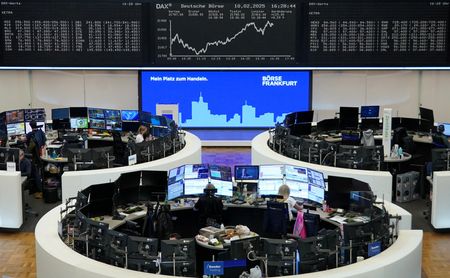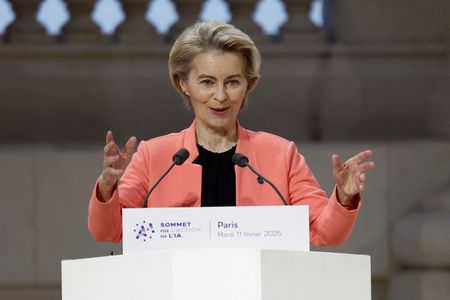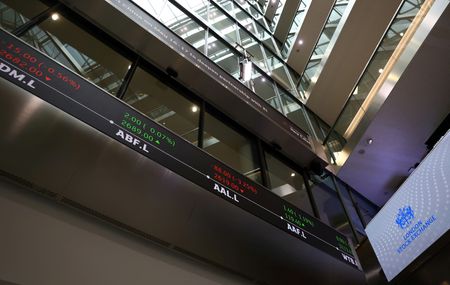By Samuel Indyk and Tom Westbrook
LONDON (Reuters) – Gold retreated from a record high while stocks were subdued on Tuesday as investors braced for further shifts in U.S. trade policy and waited to hear from Federal Reserve Chair Jerome Powell on tariffs and inflation.
President Donald Trump on Monday raised tariffs on steel and aluminium imports to 25%, and promised to announce global reciprocal tariffs within days.
Yet he also said he was considering an exemption for Australia and that the steel and aluminium measures would only take effect from March 4, seemingly confirming investor assumptions that they are a tool to gain concessions.
“Markets are assuming that Trump tariffs are a negotiating tactic, therefore they are waiting to see an actual impact from the tariffs,” said George Lagarias, chief economist at Forvis Mazars.
“I think they are waiting for the smoke to clear.”
Most major European share indexes were flat to slightly higher. The pan-continental STOXX 600 was up less than 0.2% at a new peak, while major bourses in London and Frankfurt also edged up to touch new records.
Wall Street futures were a touch softer after major U.S. indexes rose on Monday.
In Asia, Chinese markets dipped as Beijing’s retaliatory duties on U.S. energy and some goods came into effect on Monday. Hong Kong’s Hang Seng fell 1.1% after earlier notching a four-month peak. The index has rallied more than 12% in a month on investor enthusiasm for artificial intelligence and chip stocks.[.HK]
Among the biggest movers in Hong Kong trade were electric vehicle stocks, with BYD’s Hong Kong shares hitting a record high after the company rolled out free smart driving features on almost all models including its Seagull, which costs just $9,555. Shares in the rest of the sector fell heavily.
Gold retreated after earlier hitting a record peak just above $2,942 an ounce, having rallied 62% since the low of $1,809.50 an ounce on October 6, 2023. It was last at $2,887 an ounce.
Forvis Mazars’s Lagarias said physical demand and expectations of higher inflation linked to tariffs were behind the move higher.
“Central banks, especially China, and Indian consumers are buying,” Lagarias said.
“Speculation of inflation also tends to drive gold upwards.”
FOREX
In currency trade, the U.S. dollar index edged slightly lower as markets awaited Fed Chair Powell’s semiannual testimony to Congress later on Tuesday.
His comments on tariffs and inflation are likely to be closely monitored, after the Fed held its interest rate steady last month following three straight rate cuts.
“The message from Powell after the January meeting was that the Fed is in no hurry to cut further as long as the economy is strong and we see no reason for him to change that message,” said Elisabet Kopelman, U.S. economist at SEB.
Against the Japanese yen, the dollar rose 0.2% at 152.33 and it sat at $1.0324 per euro.
The European Union said it would respond with “firm and proportionate countermeasures” after Trump imposed steel and aluminium tariffs.
The Chinese yuan weakened past the 7.3 per dollar level and traded at 7.3067 on Tuesday.
Benchmark 10-year U.S. Treasury yields edged up to 4.535%, with traders largely shrugging off – for now – Trump appearing to question U.S. government debt figures.
“The markets are likely to be wanting to see more details about what this might mean,” said Mark Elworthy, head of fixed income, currency and commodity trading at Bank of America in Australia, with questions over whether Trump was possibly referring to internal departmental ownership of U.S. debt or the accounting treatment of Treasuries.
“I’m only guessing, but it will be interesting to see if more comes of this in the coming days.”
U.S. crude rose 1.7% to $73.54 a barrel, while Brent crude rose 1.7% to $77.17 due to concerns over Russian and Iranian oil supply.
(Reporting by Samuel Indyk and Tom Westbrook, editing by Ed Osmond)












